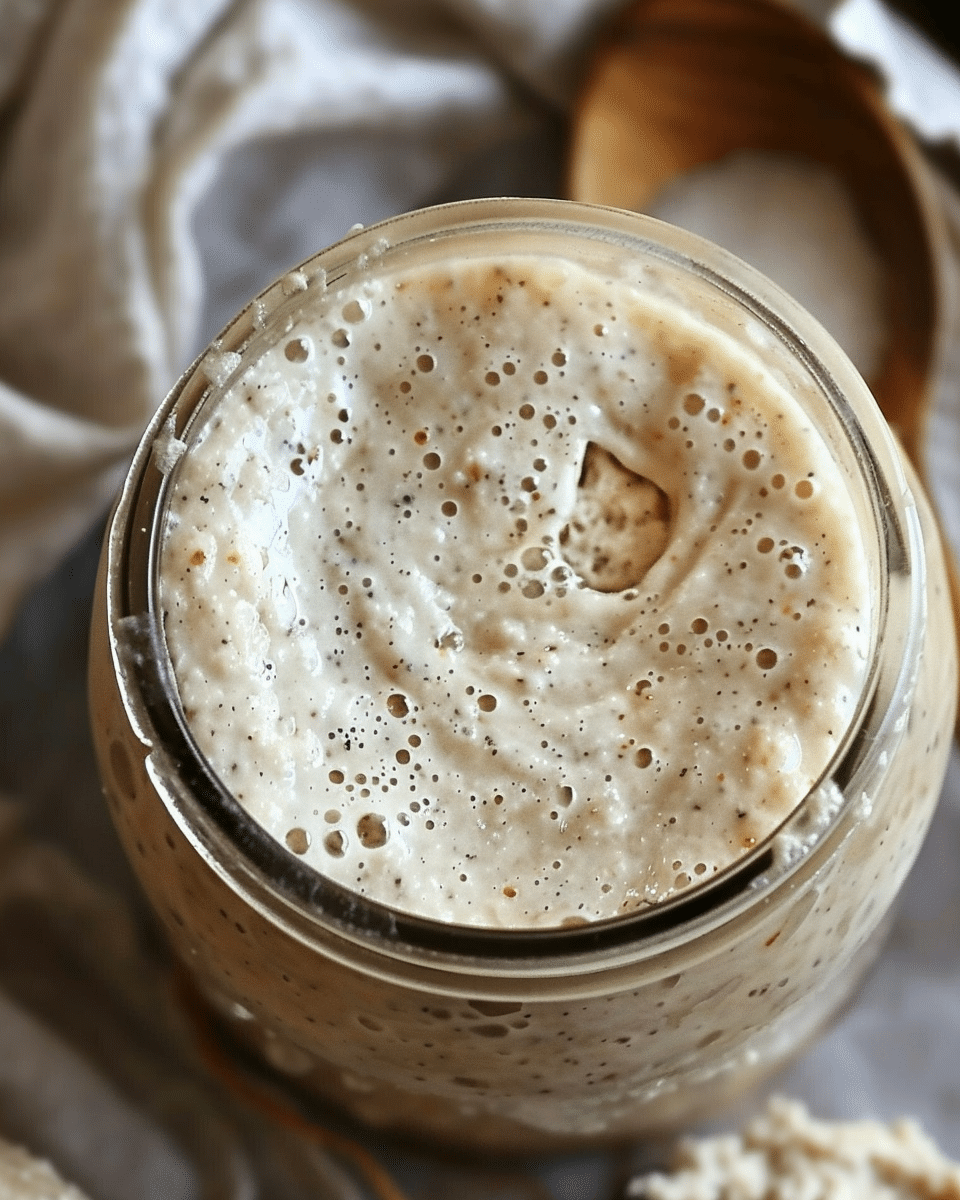There’s something incredibly special about the tangy aroma and rustic flavor of homemade sourdough bread. Everything starts with a sourdough starter – a simple yet essential component that gives your bread its unique flavor and texture. The best part? Making your own starter is rewarding, and it allows me to customize the flavor profile of my bread. It takes a little patience, but the results are well worth it. In this guide, I’ll walk you through the process of creating a sourdough starter from scratch, using just a few basic ingredients.
Why You’ll Love This Recipe
Creating a sourdough starter from scratch is a fun and satisfying process. I love how it allows me to take control of the flavor of my bread from the very beginning. The fermentation process brings natural yeasts and bacteria into the mix, which is key to developing that signature sourdough taste. And once the starter is active, I can use it for all sorts of sourdough recipes – from classic loaves to pizza dough and even pancakes. Plus, I get to watch the transformation of a simple flour-water mixture into something that’s alive with flavor.
Ingredients
1 cup of all-purpose flour
1/2 cup of lukewarm water
(Tip: You’ll find the full list of ingredients and measurements in the recipe card below.)
Directions
Mix Flour and Water: I start by combining 1 cup of all-purpose flour with 1/2 cup of lukewarm water in a clean glass or plastic container. I stir until everything is thoroughly combined and there are no lumps.
Cover and Rest: I cover the container loosely with a clean kitchen towel or plastic wrap to allow airflow, and then place it in a cozy spot in my kitchen, away from direct sunlight.
Allow Fermentation: I let the mixture sit at room temperature for about 24 hours. During this time, natural fermentation starts to occur, and I may begin to see bubbles forming on the surface.
Discard and Feed: After 24 hours, it’s time to feed the starter. I discard half of the mixture to regulate acidity and yeast activity, and then I add 1/2 cup of all-purpose flour and 1/4 cup of lukewarm water to the remaining mixture. I stir until it’s well combined.
Repeat Feeding Routine: I cover the container again and let it rest at room temperature for another 24 hours. I continue this feeding routine every day, discarding half of the mixture and replenishing it with equal parts flour and water, until the starter becomes bubbly and active.
Patience is Key: It typically takes about 5-7 days for the sourdough starter to fully develop and become active. I stay patient and consistent with the feeding routine, and soon enough, I’ll have a vibrant and flavorful starter ready for all my sourdough baking needs.
Servings and Timing
Prep Time: 5 minutes
Cook Time: 0 minutes
Total Time: 5-7 days (for fermentation)
Serving Size: 1 active sourdough starter
Method: Fermentation
Variations
While this sourdough starter recipe is simple and effective, there are a few variations to consider:
Whole Wheat Flour Starter: I can substitute whole wheat flour for all-purpose flour to create a more robust flavor. Whole wheat flour introduces more nutrients and can help speed up fermentation.
Rye Flour Starter: Rye flour can also be used to create a starter that has a distinct earthy flavor and may ferment more quickly due to its high nutrient content.
Water Temperature: Lukewarm water is essential for activating the natural yeast, but if the water is too hot or too cold, it can hinder fermentation. I always make sure the water is warm, but not hot.
Storage/Reheating
Once my sourdough starter is fully developed, I store it in the fridge to slow down fermentation. If I’m not using it right away, I can feed it once a week and keep it active. Before using it in a recipe, I take it out of the fridge, let it come to room temperature, and feed it once or twice to revive it. If I need a larger amount, I can always increase the quantities of flour and water during the feeding process.
Related Recipes:
FAQs
How do I know when my sourdough starter is ready?
I know my starter is ready when it has doubled in size within 4-6 hours of feeding and has visible bubbles throughout the mixture. It should also have a pleasant, slightly tangy aroma.
Can I use cold water to make my starter?
I recommend using lukewarm water because it helps activate the natural yeasts more effectively. Cold water can slow down the fermentation process, making it take longer for the starter to develop.
How do I maintain my sourdough starter?
I maintain my starter by regularly feeding it with equal parts flour and water. If I store it in the fridge, I feed it about once a week. If it’s kept at room temperature, I feed it daily.
What should I do if my sourdough starter isn’t bubbling?
If my starter isn’t bubbling, it could be due to the temperature being too low or the water being too cold. I make sure the starter is in a warm spot and give it more time. If it’s been more than a week with no progress, I might try using a fresh batch of flour and water.
Can I use whole wheat or rye flour for my starter?
Yes, I can use whole wheat or rye flour for my starter. These flours provide more nutrients for the fermentation process and can give the starter a slightly different flavor profile. However, I may need to adjust the feeding schedule depending on the flour used.
Conclusion
Making a sourdough starter from scratch is an enjoyable and rewarding process. The key is patience and consistency. Once I’ve gone through the fermentation process and my starter is bubbly and active, I’m ready to bake delicious sourdough bread or use it in a variety of other recipes. With a little time, I’ll have a vibrant starter that’s full of flavor and ready to become the foundation of all my sourdough creations.
📖 Recipe:
Print
Sourdough Starter
5 Stars 4 Stars 3 Stars 2 Stars 1 Star
No reviews
- Author: Isabella
- Total Time: 5-7 days (for fermentation)
- Yield: 1 active sourdough starter
- Diet: Vegan
Description
Learn how to make a sourdough starter from scratch with this easy-to-follow guide. Creating your own starter gives you complete control over the flavor and texture of your homemade sourdough bread. In this step-by-step process, discover how to cultivate natural yeasts with just flour and water, and enjoy the transformation into a bubbly, active starter ready for baking.
Ingredients
1 cup of all-purpose flour
1/2 cup of lukewarm water
Instructions
-
Mix Flour and Water: Combine 1 cup of all-purpose flour with 1/2 cup of lukewarm water in a clean glass or plastic container. Stir thoroughly to eliminate lumps.
-
Cover and Rest: Cover the container loosely with a clean kitchen towel or plastic wrap, allowing airflow, and place it in a warm spot, away from direct sunlight.
-
Allow Fermentation: Let the mixture sit at room temperature for 24 hours. You should begin to see bubbles forming on the surface as fermentation begins.
-
Discard and Feed: After 24 hours, discard half of the mixture to regulate acidity and yeast activity. Add 1/2 cup of flour and 1/4 cup of lukewarm water to the remaining mixture and stir well.
-
Repeat Feeding Routine: Cover the container again and let it rest at room temperature for another 24 hours. Continue this daily feeding routine until the starter is bubbly and active (usually 5-7 days).
Notes
Patience is Key: It takes time for the starter to develop fully. Be consistent with feeding, and you’ll eventually have a bubbly, flavorful starter.
Water Temperature: Lukewarm water (not hot) is essential for activating the yeast. Cold water can slow down the fermentation process.
Flour Variations: Try using whole wheat or rye flour for a more robust flavor. These types of flour can speed up fermentation due to their higher nutrient content.
- Prep Time: 5 minutes
- Cook Time: 0 minutes
- Category: Bread, Sourdough
- Method: Fermentation
- Cuisine: American
Nutrition
- Serving Size: 1 active sourdough starter









